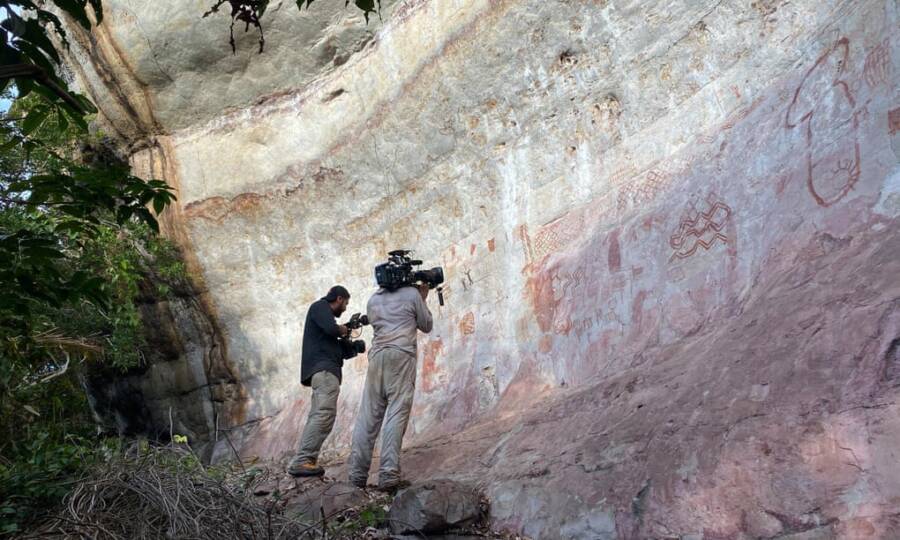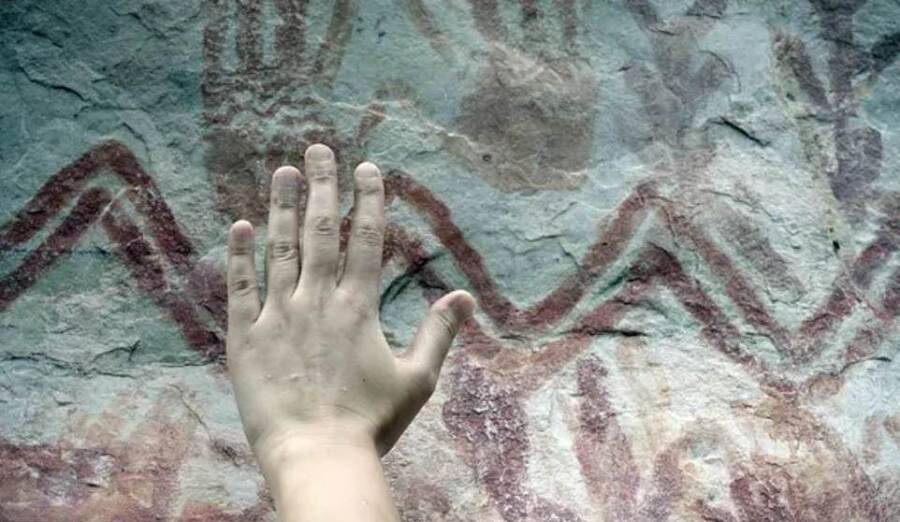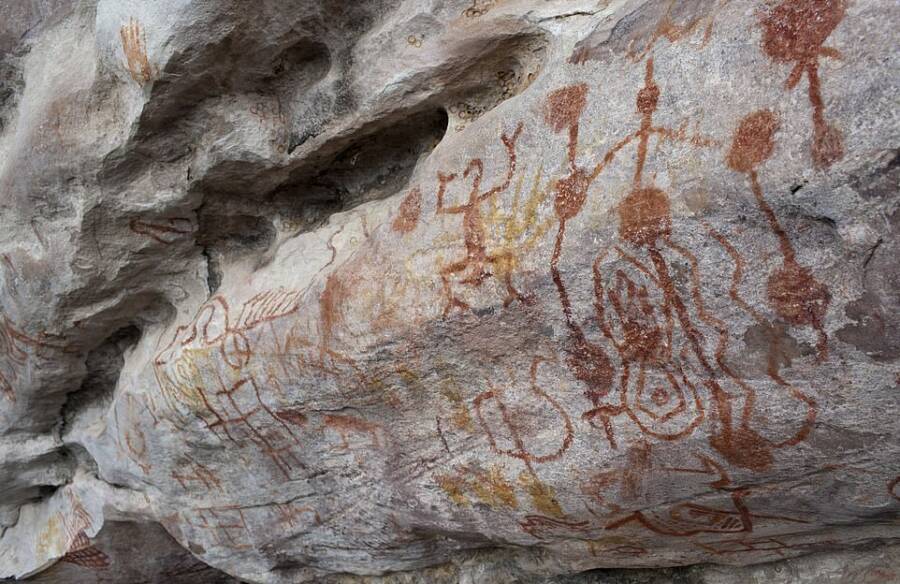"Every turn you do, it's a new wall of paintings."

Ella Al-ShamahiThe discovery will be aired as part of a documentary series.
Archaeologists have discovered tens of thousands of ancient paintings dating back some 12,500 years in the Colombian jungle. These prehistoric depictions of animals and humans were found adorning cliff faces that stretch across nearly eight miles. On top of that, some depict long-extinct ice age animals.
According to the Daily Mail, archaeologists were stunned to find countless human handprints at the site, as well. Funded by the European Research Council, the British-Colombian team had no idea what awaited them in the Chiribiquete National Park — but is now finally ready to share the remarkable discovery with the world.
Perhaps most exciting were images of animals like mastodons and paleolamas, the prehistoric relatives of elephants and camels. The cliff face art also includes giant sloths and ice age horses, all of which were clearly seen and painted by some of the first humans to ever reach the Amazon.
According to The Guardian, the find has been aptly lauded as “the Sistine Chapel of the ancients.” Based on the sheer scale and plethora of paintings, experts say it’ll take generations to properly analyze. While it was uncovered last year, the find was kept secret for a documentary set to air on Britain’s Channel 4 in December.

Wild Blue MediaMany of the paintings are so high up that drones are needed to view them.
“When you’re there, your emotions flow… We’re talking about several tens of thousands of paintings,” said lead archaeologist José Iriarte, professor of archaeology at Exeter University. “It’s going to take generations to record them… Every turn you do, it’s a new wall of paintings.”
The site is so remote that it took experts a two-hour drive from Chiribiquete National Park to Serranía de la Lindosa — followed by a four-hour hike to reach it. After this long journey, the team was awed to discover such extensive paintings.
Regional natives of the Amazon didn’t keep written records until fairly recently. With a humid climate and high levels of acid in the soil, nearly every trace of their tangible presence — including human remains — have been lost. Most about the region’s history before 1500 has been inferred from ceramics and arrowheads.
Most native tribes of the Amazon are believed to have descended from the first prehistoric group of migrants to cross the Bering Land Bridge around 17,000 years ago. The discovery is thus sure to shed unprecedented light on various aspects of their culture.

Wild Blue MediaThe remarkable handprints are estimated to be as old as 12,500 years.
“We started seeing animals that are now extinct,” said Iriarte. “The pictures are so natural and so well made that we have few doubts that you’re looking at a horse, for example. The ice-age horse had a wild, heavy face. It’s so detailed, we can even see the horse hair. It’s fascinating.”
While it’s yet unclear exactly which tribe was responsible for the uncovered art, there are some preliminary wagers at hand. Both the Yanomami and Kayapo tribes have been around for thousands of years and appear to be likely candidates.
Of course, not everything worth doing is easy — and the region’s more hostile factors rapidly made that clear for Iriarte and his team. Ella Al-Shamahi, presenter of the upcoming Channel 4 documentary series Jungle Mystery: Lost Kingdoms of the Amazon, spoke about these hidden threats.
“Caimans are everywhere, and we did keep our wits about us with snakes,” she said, recalling a giant bushmaster, “the deadliest snake in the Americans with an 80 percent mortality rate” which the team encountered in the dead of night. “You’re in the middle of nowhere.”

Wild Blue MediaAl-Shamahi recalled having to navigate both deadly animals and guerrillas to reach the site.
Unfortunately, there was another lethal threat abounding in the jungle not to be taken lightly — the Farc. Colombia suffered decades of civil war between these guerrillas and the government, with a shaky truce and heavy militant presence in the jungles not particularly calming.
Fortunately, they allowed the experts entry.
“When we entered Farc territory, it was exactly as a few of us have been screaming about for a long time,” said Al-Shamahi. “Exploration is not over. Scientific discovery is not over but the big discoveries now are going to be found in places that are disputed or hostile.”
It was only last week that evidence of ancient hallucinogenic rituals were uncovered in California. It seems these Colombian tribes engaged in the same, as paintings of psychoactive plants were also found on the walls.
“For Amazonian people, non-humans like animals and plants have souls, and they communicate and engage with people in cooperative or hostile ways through rituals and shamanic practices that we see depicted in the rock art,” said Iriarte.

FacebookThe research will continue as pandemic-centric regulations loosen.
“It’s interesting to see that many of these large animals appear surrounded by small men with their arms raised, almost worshipping these animals,” added Iriarte.
For Al-Shamahi, one of the more intriguing aspects was the height of some of these illustrations. They were so elevated that they could only be viewed with camera-drones and some depicted wooden towers with figures bungee jumping off of them. Still, the historical context blew her away more than anything.
“One of the most fascinating things was seeing ice age megafauna because that’s a marker of time. I don’t think people realize that the Amazon has shifted in the way it looks. It hasn’t always been this rainforest. When you look at a horse or mastodon in these paintings, of course they weren’t going to live in a forest.”
“They’re too big. Not only are they giving clues about when they were painted by some of the earliest people — that in itself is just mind-boggling — but they are also giving clues about what this very spot might have looked like: more savannah-like.”
As it stands, the COVID-19 pandemic has put a damper on continued research here. Fortunately for us, we’ll get to see these initial discoveries up close when the documentary series airs its episode on the matter on Dec. 12.
After learning about the “Sistine Chapel of the ancients” in Colombia, read about the discovery of a 14,000-year-old settlement in Canada. Then, learn about the 15,000-year-old woolly mammoth traps found in Mexico.





